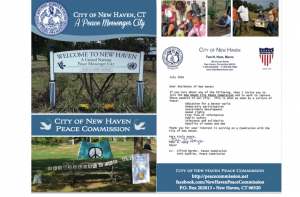. .DEMOCRATIC PARTICIPATION. .
by David Adams, City of New Haven Peace Commission
There is a new sense of urgency in the conversation with people passing by and stopping at the table for the Peace Commission at the Farmer’s Market in New Haven. “We’ve got a lot more work to do, now that Trump has been elected,” this is a common refrain. “Now, more than ever, we need to work together for peace.”

First two pages of Peace Commission brochure
Click on image to enlarge
We are getting the same reaction of urgency in the interview of local activists as we compile the annual report for the Commission, The State of the Culture of Peace in New Haven. It is not only a discussion of what happened in the city during 2016, but even more so, what we need to be doing in 2017 and beyond. As one person remarked, “When the going gets tough, the tough get going.”
The Peace Commission has been part of city government in New Haven for almost 30 years now, but there is the feeling that we have to increase our outreach and involve new people, new ideas, and, above all, new actions. It is no longer enough to hold a few ceremonies a year for Hiroshima Day and International Peace Day. We need to be out there on the front lines for the defense of human rights, for the development of restorative justice and sanctuary cities and affordable housing, which are necessary if we are to have peace in our community.
The new brochure that we are handing out (see image above) includes a letter from our mayor that invites New Haveners to join the Commission and contribute new ideas and actions to promote all of the aspects of the culture of peace: human rights, peace education, sustainable development, democratic participation, equality of women, tolerance and solidarity, free flow of information, and disarmament and public safety.
The brochure ends by saying that we want to “make New Haven a model for cities across America and around the globe to change the world from its cuture of war and violence to a cutlure of peace and nonviolence.